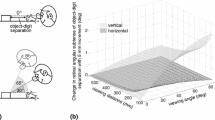Abstract
Previous work has demonstrated that monocular vision affects the kinematics of skilled visually guided reaching movements in humans. In these experiments, prior to movement onset, subjects appeared to be underestimating the distance of objects (and as a consequence, their size) under monocular viewing relative to their reaches made under binocular control. The present series of experiments was conducted to assess whether this underestimation was a consequence of a purely visual distance underestimation under monocular viewing or whether it was due to some implicit inaccuracy in calibrating the reach by a visuomotor system normally under binocular control. In a purely perceptual task, a group of subjects made similar explicit distance estimations of the objects used in the prehension task under monocular and binocular viewing conditions, with no time constraints. A second group of subjects made these explicit distance estimations with only 500-ms views of the objects. No differences were found between monocular and binocular viewing in either of these explicit distance-estimation tasks. The limited-views subjects also performed a visually guided reaching task under monocular and binocular conditions and showed the previously demonstrated monocular underestimation (in that their monocular grasping movements showed lower peak velocities and smaller grip apertures). A distance underestimation of 4.1 cm in the monocular condition was computed by taking the y intercepts of the monocular and binocular peak velocity functions and dividing them by a common slope that minimised the sum of squares error. This distance underestimation was then used to predict the corresponding underestimation of size that should have been observed in the monocular reaches – a value closely approximating the observed value of 0.61 cm. Taken together, these results suggest that the monocular underestimation in the prehension task is not a consequence of a purely perceptual bias but rather it is visuomotor in nature – a monocular input to a system that normally calibrates motor output on the basis of binocular vision.
Similar content being viewed by others
Author information
Authors and Affiliations
Additional information
Received: 30 November 1998 / Accepted: 19 June 1999
Rights and permissions
About this article
Cite this article
Servos, P. Distance estimation in the visual and visuomotor systems. Exp Brain Res 130, 35–47 (2000). https://doi.org/10.1007/s002210050004
Issue Date:
DOI: https://doi.org/10.1007/s002210050004




